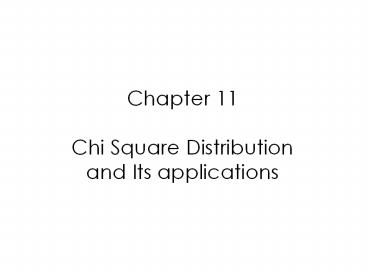Chapter 11 Chi Square Distribution and Its applications - PowerPoint PPT Presentation
Title:
Chapter 11 Chi Square Distribution and Its applications
Description:
Chapter 11 Chi Square Distribution and Its applications What is a Chi Square? Chi Square is another probability distribution (like Normal and Student t) Symbol: 2 ... – PowerPoint PPT presentation
Number of Views:157
Avg rating:3.0/5.0
Title: Chapter 11 Chi Square Distribution and Its applications
1
Chapter 11Chi Square Distributionand Its
applications
2
What is a Chi Square?
- Chi Square is another probability distribution
(like Normal and Student t) - Symbol ?2
- Picture
0
3
What is a Chi Square? (cont)
- Features Mode (i.e. Peak) at n 2.
- Degrees of Freedom n 2.
0
4
Why ?2?
- The ?2 distribution allows you to test the
independence of two factors. - For instance, what about getting a tattoo and the
frequency of Hepatitis C? What if you got the
tattoo in a tattoo parlor? What if your cousin
Dwayne gave you that great tattoo of Count
Chocula? - The Chi Squared test for independence allows you
to decide whether the chance of having hepatitis
is independent of the tattoo status.
5
Requirements
- 1. Counted Data Condition
- Data must be in counts
- 2. Randomization Condition
- Individuals who have been counted should
- be a random sample from some
- population.
- 3. Expected Cell Frequency Condition
- The expected values (which you will
- calculate) should all be at least 5.
6
What to do?
- Use a contingency table to find the differences
between observed and expected values.
7
What to do?
- Use a contingency table to find the differences
between observed and expected values.
d.f. (R-1)(C-1) where R and C are the number of
rows/columns
8
Lets Try one
- We have counts of 626 individuals categorized
according to their tattoo status and their
hepatitis status.
Hep C No Hep C Total
Tattoo, Parlor 17 35 52
Tattoo, Elsewhere 8 53 61
No Tattoo 22 491 513
Total 47 579 626
9
- We want to test whether tattoo status and
hepatitis status are independent. - HO Tattoo status and hepatitis status are
independent - HA Tattoo status and hepatitis status are not
independent - Check the conditions
- 1. Counts of data categorized
- 2. While you dont have the information, you can
assume that they were selected to avoid biases. - 3. Well find out when we determine E for each
cell
10
Compute E
Hep C No Hep C Total
Tattoo, Parlor 17 35 52
Tattoo, Elsewhere 8 53 61
No Tattoo 22 491 513
Total 47 579 626
48.096
3.904
56.420
4.580
38.516
474.484
11
Notice
- There are some values below 5 well continue
from here for the sake of the data. - What are the degrees of freedom?
- Find the ?2 value.
- Using a table, the value for P(?2 gt57.91)
2
57.91
Less than .0001
12
Conclusion
- The P-value is very small, so I reject the null
hypothesis and conclude that hepatitis status is
not independent of tattoo status.
13
Resources
- www.microbiologybytes.com/maths/graphics/chi.gif































